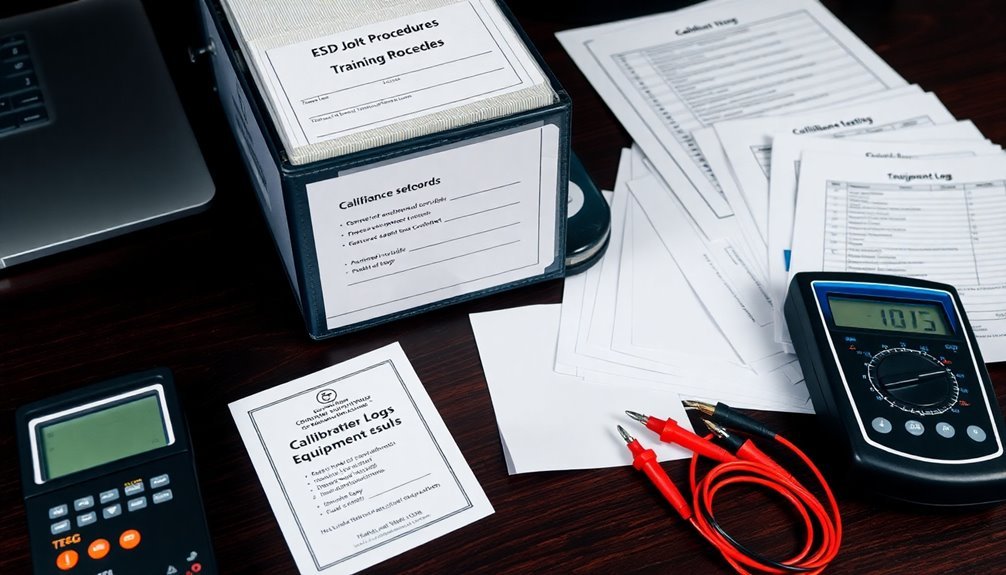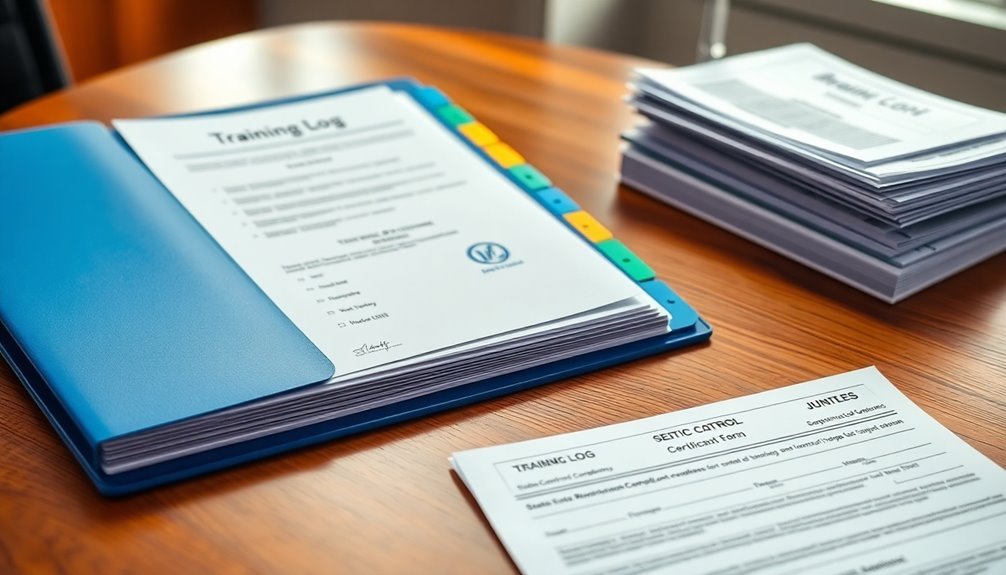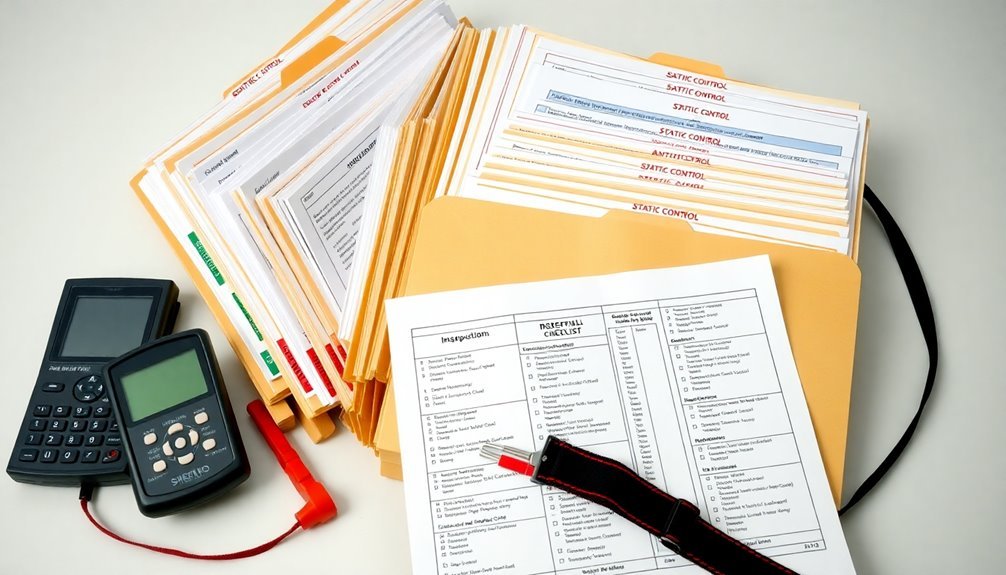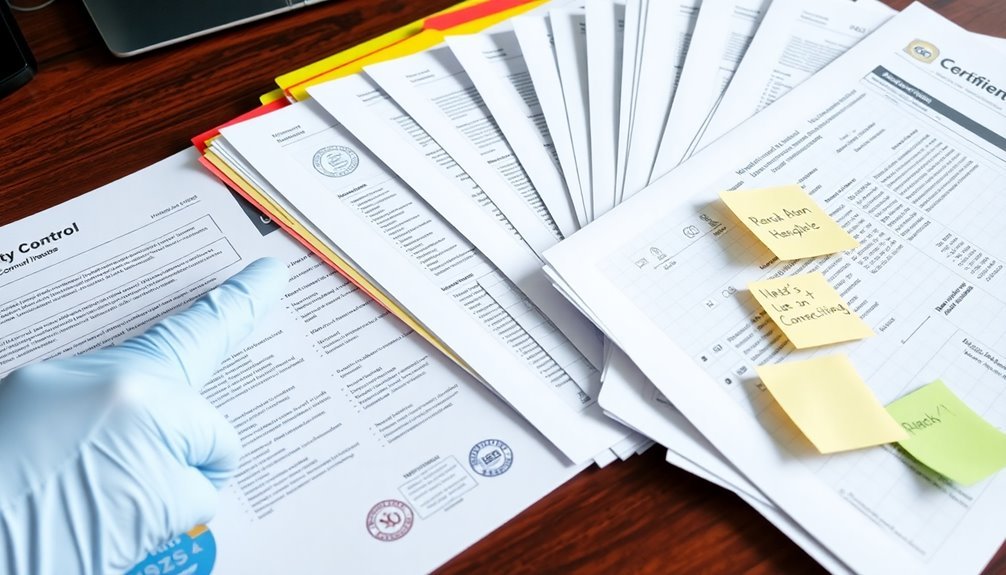Auditors will scrutinize your static control documentation across several key areas. You'll need thorough calibration and testing records that show equipment reliability and traceability to national standards. Your program must include detailed training logs, certification records, and incident reports with corrective actions taken. They'll also examine your maintenance schedules, environmental monitoring data, and material handling control documents. All records should demonstrate compliance with OSHA regulations and include clear audit trails with review signatures. Documentation must be current, organized, and readily accessible – proper preparation will help you navigate the complexities of a successful audit process.
Static Control Program Documentation Requirements

A well-structured documentation system forms the backbone of any effective static control program. When preparing for an audit, you'll need to guarantee your ESD control program documentation includes both administrative and technical requirements while demonstrating full implementation and integration with your quality system.
Your primary documentation should establish how you'll identify and eliminate defects while preventing their introduction into your processes. You'll need to show auditors that your program is extensive and specifically tailored to your company's needs. This includes detailed compliance verification plans that outline your measurement processes, test methods, and equipment specifications. Regular reviews and updates of the documentation ensure the program maintains its effectiveness and compliance standards.
Don't forget to maintain thorough training records, as they're essential for demonstrating personnel competency. You'll need to document minimum qualifications and show evidence of regular training updates.
Your documentation must also include audit records that verify program compliance and highlight any significant findings.
Remember to keep all your verification records current and easily accessible. These records serve as evidence of your conformity to requirements and should clearly demonstrate how you're monitoring and improving your ESD control program over time.
Equipment Calibration and Testing Records
You'll need robust documentation that outlines your calibration standards and measurement device test procedures to meet regulatory requirements and prove static control program effectiveness.
Your records must show traceability to national standards, include detailed test results, and demonstrate proper maintenance of all static control measurement equipment.
Following record retention best practices, you should maintain these calibration and testing records in an organized system that allows quick access during audits while ensuring all documentation is complete, accurate, and routinely updated. Implementing a systematic approach to managing calibration records helps improve forecasting and decision-making for equipment maintenance needs.
Calibration Standards Documentation Controls
Maintaining precise calibration documentation controls serves as the cornerstone of equipment reliability and audit compliance. You'll need to guarantee your calibration records include thorough instrument identification, precise measurement data, and complete traceability to national standards. Your documentation system must protect sensitive information through encryption while maintaining detailed audit trails of all activities. Quality management systems require comprehensive calibration documentation to maintain ISO certifications and demonstrate measurement accuracy.
| Documentation Element | Control Requirement |
|---|---|
| Instrument Details | Serial number, model, location, tag number |
| Measurement Data | Before/after readings, tolerances, uncertainties |
| Environmental Factors | Temperature, humidity, specific conditions |
| Personnel Information | Technician name, qualifications, certifications |
| Compliance Records | Standards adherence, out-of-tolerance actions |
You must implement automated alerts for recalibration schedules and maintain strict interval management to prevent overdue calibrations. Store your records with proper security measures, guaranteeing they're easily accessible for auditors while remaining protected from unauthorized access. Remember to document all environmental conditions during calibration procedures and maintain detailed records of any adjustments made. Include maximum permissible errors and measurement uncertainties in your documentation, and guarantee you're recording both initial and subsequent calibration dates for each instrument.
Measurement Device Test Procedures
Precise measurement device test procedures form the bedrock of reliable equipment performance and regulatory compliance. You'll need to maintain detailed documentation that outlines specific test methods, validation protocols, and performance criteria for each piece of equipment.
Your test procedures must include step-by-step instructions for verifying equipment functionality, along with acceptable ranges for accuracy and precision. These procedures must comply with 21 CFR 820.72(a) requirements for routine calibration. You'll want to guarantee all testing is performed under controlled environmental conditions, which you'll need to document alongside your test results.
When documenting your measurement device tests, you must record the unique equipment identifier, test date, personnel conducting the test, and thorough results including both as-found and as-left data.
Don't forget to reference the calibration standards used and verify they're traceable to national or international standards.
If you discover any equipment that's out of specification during testing, you'll need to follow established error handling procedures. This includes documenting the deviation, taking corrective actions, and revalidating the equipment's performance.
Remember to store your testing records within your quality system's document control framework, making them readily accessible for auditor review.
Record Retention Best Practices
After establishing robust test procedures, proper record retention becomes the next critical component of your quality system.
You'll need to maintain calibration records for a minimum of four years to meet regulatory requirements and guarantee compliance with standards like ISO 17025:2017. Your records must include detailed information about each piece of equipment, including serial numbers, model information, and manufacturer data.
Make sure you're documenting every calibration event with specific information about measurement results, tolerances, and any adjustments made during the process. Continuous professional development is essential for maintaining staff expertise in calibration documentation.
You should record environmental conditions, technician details, and dates of both initial and subsequent calibrations. It's crucial to implement a secure storage system that maintains the integrity of these records while keeping them easily traceable.
You'll want to establish a standardized procedure for entering and managing calibration data, preferably using appropriate software to streamline the process.
Don't forget to conduct regular audits of your records to verify compliance and accuracy. Train your personnel thoroughly on proper record-keeping procedures to promote consistency and reliability in your documentation system.
Your records must demonstrate clear traceability to national or international standards for audit purposes.
Personnel Training and Certification Logs

Personnel training and certification logs serve as critical documentation for ESD control programs, proving that employees have received proper instruction and maintain current qualifications.
You'll need to maintain detailed records of all initial and recurrent training sessions, including sign-in sheets and certificates of completion, to demonstrate compliance with ANSI/ESD S20.20-2014 standards.
Your training logs should document specific elements that auditors will review: the date of training, content covered, certification achieved, and verification of employee comprehension. The system should include automated email alerts when certifications are approaching expiration.
You must retain these records for at least two years after an employee completes or discontinues training. It's crucial to implement a tracking system that alerts you when staff members are due for refresher training or recertification.
During audits, you'll need to present evidence that your training program meets objectives for material retention and emphasizes static control importance.
Your logs should also demonstrate regular compliance verification through detailed audit records.
Make sure you're documenting any corrective actions taken when training deficiencies are identified, as auditors will look for evidence that you're actively maintaining and improving your ESD control program's effectiveness.
Facility Environmental Monitoring Reports
Building upon your ESD control documentation requirements, facility environmental monitoring reports provide thorough data about your workspace conditions that directly impact static control effectiveness. You'll need to maintain detailed records of temperature, humidity, airflow, and power consumption measurements that demonstrate your facility's adherence to ESD control parameters.
Your monitoring system should collect data from multiple sensors positioned throughout your facility, with particular attention to critical areas where static-sensitive components are handled. You'll want to guarantee your reports include regular calibration records and maintenance logs for all monitoring equipment. Implementing dynamic reports can provide an effective blend of historical data and real-time updates when auditors need to verify compliance.
| Parameter | What to Monitor | Documentation Needed |
|---|---|---|
| Temperature | Rack-level readings | Daily logs, trend analysis |
| Humidity | Room-level RH% | Hourly measurements, deviation reports |
| Airflow | Distribution patterns | Flow maps, hotspot identification |
| Power Usage | Energy consumption | Usage trends, efficiency metrics |
| Sensor Status | Calibration data | Maintenance records, accuracy tests |
Make sure your reports incorporate both real-time monitoring data and historical trends, allowing auditors to verify long-term compliance with ESD control requirements. You'll need to demonstrate how you've used this information to implement corrective actions and facility improvements when environmental parameters fall outside acceptable ranges.
Static Control Incident Reports

Proper documentation of static control incidents forms the backbone of your ESD management system. You'll need to maintain detailed reports of any unexpected events or issues that occur during testing or operational processes, as these documents help identify and track defects affecting your facility's performance.
Your incident reports should capture several essential elements: the date, time, location, detailed description of the event, individuals involved, and immediate actions taken. Make sure you're classifying incidents appropriately, whether they're safety-related, security breaches, equipment failures, or sentinel events. Having a standardized report template ensures consistency and completeness in your incident documentation.
Each report must include a thorough assessment of root causes and the corrective measures you've implemented. To satisfy auditor requirements, you'll want to guarantee your incident reports demonstrate clear risk management practices and compliance with regulatory standards.
You should distribute these reports to relevant authorities and management while maintaining proper documentation trails. Remember to use the data from these reports to analyze trends and patterns, which will help you predict and prevent future incidents.
This proactive approach shows auditors you're committed to continuous improvement and maintaining effective static control measures.
Maintenance and Inspection Schedules
How often should you inspect your static control measures? Your ESD control program requires regular audits, typically on a monthly basis, to verify compliance and proper equipment functioning.
You'll need to implement a systematic approach that includes both routine checks and thorough evaluations. Your maintenance schedule should include daily monitoring of critical static control elements within your EPA (ESD Protected Area).
You'll want to use detailed checklists and specialized test equipment to confirm all components meet ANSI/ESD S20.20 standards. When conducting audits, you'll need to employ sampling techniques and statistical analysis to maintain consistency across your facility.
While fire and life safety systems follow strict annual and semi-annual inspection requirements, your ESD control program needs more frequent attention.
You'll find that continuous monitoring helps identify potential issues before they become problems. Make sure you're documenting all inspections thoroughly, as auditors will review these records to verify your compliance.
You should adjust your preventive maintenance schedules based on historical data and performance trends, confirming your static control measures remain effective year-round.
Material Handling Control Documents

Your material handling control documents must include clear movement control processes that track materials from receipt through storage and final issuance.
You'll need to maintain daily flow documentation that records all material transfers, locations, and responsible personnel using standardized forms like Material Receipt Notes and Material Requisition Slips.
These documents should integrate with your automated systems and quality management protocols to guarantee complete traceability for audit purposes.
Movement Control Process Documentation
Maintaining accurate movement control documentation forms the backbone of effective material handling systems.
You'll need to guarantee your Material Receipt Notes capture essential details like serial numbers, purchase order information, and supplier data, while properly documenting quantities received, accepted, and rejected.
Your document templates must include thorough Shelf Life Items lists and Material Requisition Slips with specific information for each item's tracking.
Store Assessment Forms should detail product specifications, batch numbers, and verification status. You'll also need to document storage and physical conditions thoroughly.
When preparing for audits, you'll want to focus on demonstrating your secure storage facilities and retrieval procedures.
Your documentation should show real-time material tracking capabilities and proper bulk handling equipment usage. Auditors will examine these records closely, often reperforming control activities to validate their effectiveness.
To maintain compliance, guarantee your documentation meets ISO 9001 standards and, where applicable, Quality System Regulation requirements.
You'll need to demonstrate proper document control procedures and show evidence of your CAPA system.
Remember to keep third-party confirmations and sampling test results readily accessible for inspection.
Daily Flow Documentation Standards
Through effective daily flow documentation, you'll establish reliable control over material handling operations. Your documentation must provide clear evidence of procedures performed, responsibilities assigned, and conclusions reached. You'll need to assemble these records within 60 days of report release and maintain them according to retention standards.
| Documentation Type | Required Elements | Purpose |
|---|---|---|
| Daily Procedures | Material handling details, equipment usage | Operational control |
| Training Records | Employee certifications, safety training | Compliance proof |
| Equipment Logs | Maintenance records, inspection dates | Safety verification |
| Incident Reports | Root cause analysis, corrective actions | Risk management |
| Storage Records | Stacking guidelines, clearance documentation | Safety compliance |
To meet audit requirements, you'll need to document your material handling processes systematically. This includes maintaining detailed records of training sessions, equipment maintenance, and any incidents that occur. Your documentation should demonstrate compliance with OSHA regulations, particularly 29 CFR 1910.176, and provide a clear audit trail. Remember to include evidence of review and approval for all procedures, ensuring transparency and supporting continuous improvement efforts in your material handling operations.
Frequently Asked Questions
How Often Should Static Control Documents Be Updated for Compliance?
You should update your static control documents at least six times per year, but adjust frequency based on your test results, ESD-sensitive items' criticality, and audit findings that show performance trends.
What Role Does Version Control Play in Static Control Documentation?
Version control helps you track document changes, maintain audit trails, and guarantee you're using the latest version. You'll have complete transparency of modifications, making compliance easier and preventing confusion about current documentation.
Who Is Authorized to Make Changes to Static Control Procedures?
You'll need authorization from your ESD Control Program Manager or designated ESD Point of Contact to make changes. Top management must support these changes, and they must follow established document control procedures.
Are Digital Signatures Acceptable for Static Control Document Approvals?
Yes, you'll find digital signatures are fully acceptable for static control document approvals. They're recognized by major compliance standards, provide secure authentication, and create reliable audit trails for your approval processes.
How Long Must Historical Static Control Records Be Retained?
You'll need to retain historical static control records for seven years, as required by auditing standards. If they're part of ongoing audits or legal matters, you must keep them even longer, regardless of retention periods.
In Summary
You'll need to maintain thorough documentation for your static control program to satisfy auditor requirements. Keep your calibration records, training logs, monitoring data, incident reports, maintenance schedules, and material handling procedures readily accessible and up-to-date. Regular review and organization of these documents will guarantee you're prepared for audits and demonstrate your commitment to effective static control practices.





Leave a Reply